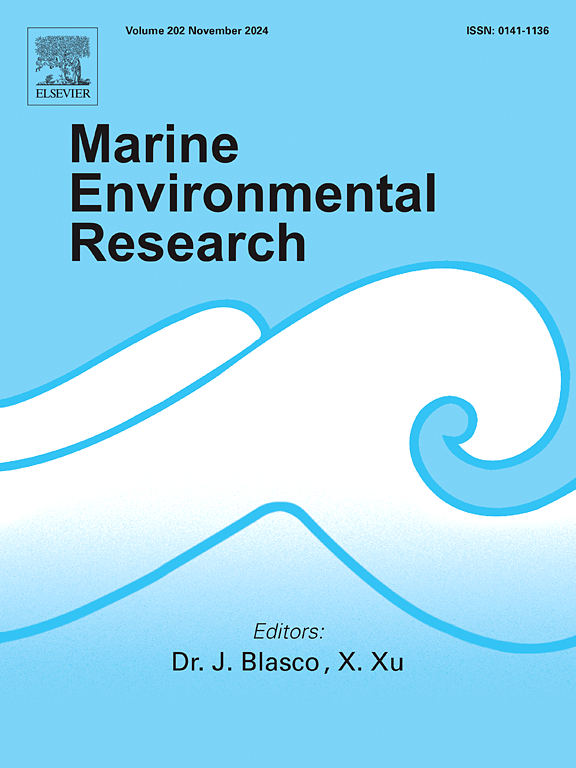环境硅酸浓度对海洋蓝藻聚藻球菌生理的影响
IF 3
3区 环境科学与生态学
Q2 ENVIRONMENTAL SCIENCES
引用次数: 0
摘要
海洋蓝藻聚藻球菌可以在其细胞内积累大量的硅(Si),可能有助于海洋中生物源硅的垂直运输。这引起了人们对了解硅在聚球菌中的摄取、亚细胞分布和化学形式的兴趣。胞内惊人的高Si浓度可能对聚球菌的生理有重要影响,但这些影响相对未被探索。在本研究中,我们研究了外部Si浓度[Si(OH)4]对两株聚球菌(CC9311和WH7803)细胞生理的影响。环境[Si(OH)4]的增加显著提高了聚藻球菌细胞总Si和水溶性Si含量,但对其生长影响不大。然而,菌株WH7803的细胞大小、体积和光合性能均显著降低,表明该菌株对细胞有一定的有害影响。环境[Si(OH)4]的增加也改变了聚球菌细胞的Derjaguin-Muller-Toporov (DMT)模量、粘附力、表面电位和元素组成。值得注意的是,在较高的[Si(OH)4]水平下,区域特异性吸附金属和体积特异性金属含量发生了显著变化,这表明海水中Si的可用性会显著影响聚球菌细胞与环境的相互作用。总的来说,本研究为海洋蓝藻聚藻球菌对不同环境硅酸浓度的生理适应提供了新的见解。本文章由计算机程序翻译,如有差异,请以英文原文为准。
Effects of ambient silicic acid concentration on the physiology of marine cyanobacterial Synechococcus
The marine cyanobacterium Synechococcus can accumulate significant amounts of silicon (Si) within its cells, potentially contributing to the vertical transport of biogenic Si in the ocean. This has prompted interest in understanding the uptake, subcellular distribution, and chemical forms of Si in Synechococcus. The surprisingly high intracellular Si concentration could have important impacts on Synechococcus physiology, but these effects have been relatively unexplored. In this study, we investigated the effects of external Si concentrations, [Si(OH)4], on the cell physiology of two strains of Synechococcus (CC9311 and WH7803). Increased ambient [Si(OH)4] significantly enhanced total cellular and water-soluble Si content in Synechococcus, but had little effect on their growth. However, the cell size, volume and photosynthetic performance were significantly reduced in strain WH7803, indicating some harmful effects in the cell. Increases in ambient [Si(OH)4] also altered the Derjaguin-Muller-Toporov (DMT) modulus, adhesion, surface potential and elemental composition of the Synechococcus cells. Notably, significant changes in area-specific adsorbed metals and volume-specific metal content were observed at higher [Si(OH)4] levels, suggesting Si availability in seawater could markedly impact the interactions between Synechococcus cell and environment. Overall, this study provides new insights into the physiological adaptations of marine cyanobacterium Synechococcus to varying environmental silicic acid concentrations.
求助全文
通过发布文献求助,成功后即可免费获取论文全文。
去求助
来源期刊

Marine environmental research
环境科学-毒理学
CiteScore
5.90
自引率
3.00%
发文量
217
审稿时长
46 days
期刊介绍:
Marine Environmental Research publishes original research papers on chemical, physical, and biological interactions in the oceans and coastal waters. The journal serves as a forum for new information on biology, chemistry, and toxicology and syntheses that advance understanding of marine environmental processes.
Submission of multidisciplinary studies is encouraged. Studies that utilize experimental approaches to clarify the roles of anthropogenic and natural causes of changes in marine ecosystems are especially welcome, as are those studies that represent new developments of a theoretical or conceptual aspect of marine science. All papers published in this journal are reviewed by qualified peers prior to acceptance and publication. Examples of topics considered to be appropriate for the journal include, but are not limited to, the following:
– The extent, persistence, and consequences of change and the recovery from such change in natural marine systems
– The biochemical, physiological, and ecological consequences of contaminants to marine organisms and ecosystems
– The biogeochemistry of naturally occurring and anthropogenic substances
– Models that describe and predict the above processes
– Monitoring studies, to the extent that their results provide new information on functional processes
– Methodological papers describing improved quantitative techniques for the marine sciences.
 求助内容:
求助内容: 应助结果提醒方式:
应助结果提醒方式:


